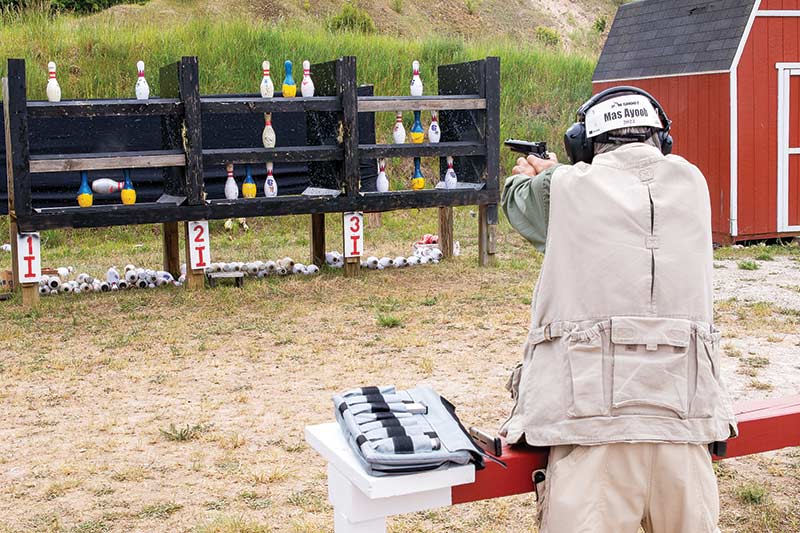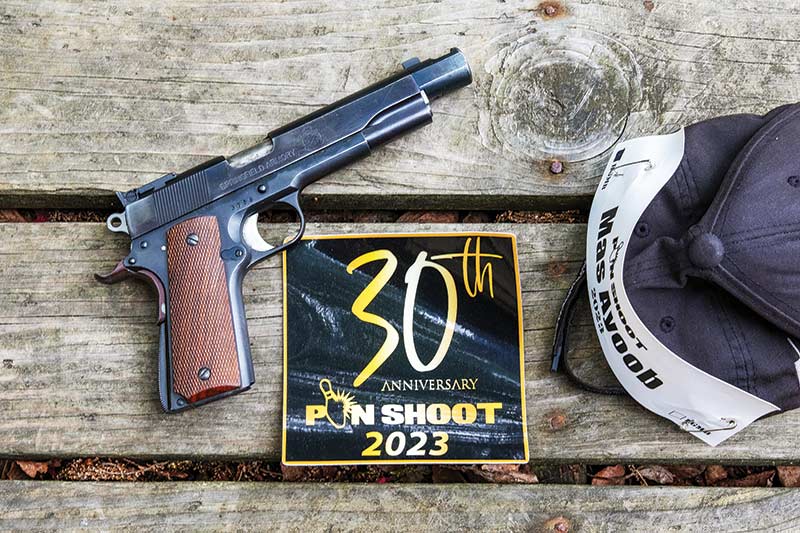Pin Shoot #30
Lessons from the match
When people compete on the firing line, there are lessons to be learned.
In 1975, Richard Davis held the inaugural bowling pin shooting match in Central Lake, Mich. Our own J.D. Jones wrote it up and I was there for all the rest of those Second Chance shoots until they stopped in 1998. The concept received its own “second chance” when Richard and his dynamic son Matt reincarnated it as The Pin Shoot in 2017. It has continued the run into the present, skipping a plague year during the pandemic. I’ve had the pleasure of being at 29 of them including this year’s, the 30th Anniversary.
There are always lessons to learn. The late Jim Cirillo of NYPD’s famed Stakeout Unit was famous for the number of shootings he engaged in. He was also a champion revolver shooter. We were on the same squad at the first Bianchi Cup in 1979. He told me he was feeling more stress than in any of his gunfights. I asked him why he thought that was, and he replied, “There weren’t all these people watching you, and there wasn’t all this time to build up to it!” He was not the only gunfight veteran I knew to say something similar.
Winning feels great. It gives you positive reinforcement and warm fuzzy feelings. Losing sucks, of course, but that’s where you learn lessons. A shooting competition isn’t training per se — but it’s testing your skills under pressure and this is part and parcel of training.
How Much Does Recoil Slow You Down?
The degree to which recoil slows you down when you’re “shooting on the clock” depends largely on just what needs to be shot. In the main events at the Pin Shoot, those chunks of wood have to be blasted three feet back off a steel table or the clock will keep running. One center hit with a powerful round — full power 10mm, say, or the more popular .45 ACP — will generally do the job with a single hit. Shoot it with a 9mm, and the lighter bullet often won’t generate enough momentum to clear the pin from the table. So, a follow-up shot to where you’re already aimed will get it off the table more quickly than if you left it lying there and came back to it later — but if you’d used a potent-enough round, you wouldn’t have had to shoot it again at all and would already have moved on to the next target.
This year for the first time there was a Minor Stock event for five pins with a 9mm. It worked because the pins were set much closer to the rear of the table. Shooters with 147-grain standard-pressure 9mm told me their pins were leaving the table okay with a single hit. I used 127-grain +P+ Winchester Ranger, which just reefed them the short distance off the back of the table.
When you fire one shot per target on multiple targets, you have time to recover from the recoil as you are transitioning to the next target and a “kick” makes less difference. Our score times were the best five out of six five-pin tables. With my Springfield 1911A1 tuned and fitted with a recoil compensator by Mike Plaxco in the 1980s (we miss you, Mike!) my overall time for 25 pins was only half a second faster than my stock gun score shot with an out-of-the-box Springfield Armory Range Officer 1911A1 .45. This just ain’t a helluva lot of difference.
Yes, I shot the 9mm Stock — same array, same rules except, as noted, the pins were closer to the rear of the table. The 9mm was an XD-M with those hot +P+ rounds. My time there was only eight-tenths of a second faster for 25 pins than with the Plaxco .45 Pin Gun, only 1.3 seconds faster than with the 5″ unmodified Range Officer .45. Both .45s were loaded with hot Federal HST 230-grain +P at nominal 950 foot-
seconds velocity.
For an experienced shooter with good grip and stance, multiple targets just don’t get shot a whole lot faster with the lighter-kicking caliber. Repeated shots on a single, static target will generally show more difference, again because there’s no transition time in which to recover from the recoil.
Trigger Pulls
While five-pin Stock Minor was new this year, the Pin Shoot has long had a provision for 9mm shooters. It is currently called “9×12.” Your gun can hold as many rounds as you want, but you face 12 pins. To allow for the smaller bullets, you only have to tip them over, not knock them all the way off the table.
Unlike the Main Events, which are one set of six tables per shooter per gun division, 9×12 is an “optional” event you can re-enter for another try. I did it once with the kind of 9mm I usually run there, a Springfield XD-M with a superb, super-light trigger pull for competition shooting by the manufacturer’s Custom Shop. I then tried it again with a gun I was testing for another publication, the Springfield 9mm Prodigy, which was straight out of the box with a trigger pull in the 4-lb. range. The 3-lb. trigger target pistol — by almost every standard too dangerously light for high-stress defensive use — was only two-tenths of a second faster knocking down 12 pins than the 4-lb. trigger, which falls within the acceptable “duty” trigger pull range of such a 1911 pistol.
This very match was the place where Jerry Miculek first won fame for his amazing revolver skills. What was even more amazing was his long-barreled Smith & Wesson Model 27 .357 Magnum had a very heavy double-action pull, somewhere in the 12- to 14-lb. range, yet he beat all comers for speed and accuracy. The reason? The stronger trigger return spring did exactly the job and returned the trigger for the subsequent shot sooner.
So, you see, the Pin Shoot wasn’t just a super fun match, it was also an arena for learning. I hope to see you at the next one in June of 2024.






